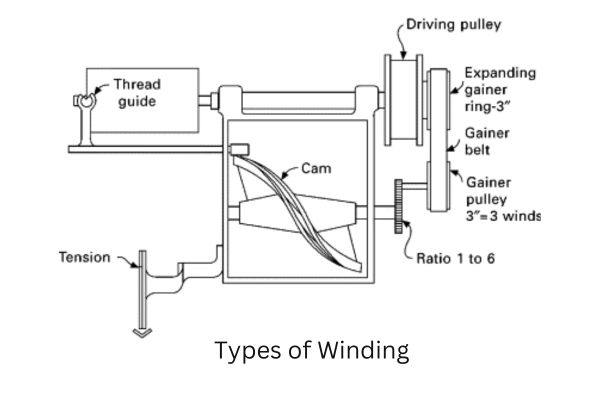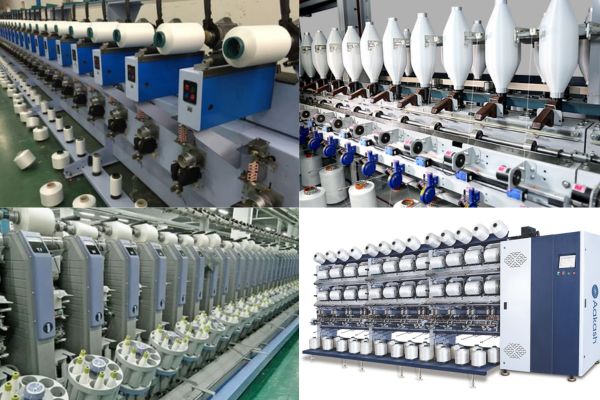The yarn obtained from spinning is lacking in quantity and quality for weaving. It has many imperfections such as thick places, thin places and slubs. These will cause difficulties in further operations and ultimately hamper the Textile Fiber Properties and Characteristics. Moreover, the yarn packages from the spinning section are inadequate in volume and require transfiguration into larger packages. To overcome these issues the yarn has to undergo a winding process.
In this content we will learn about the winding, objectives, types, formulas and applications.
Table of Contents
What is winding?
Definition of Winding Process: Winding is a method of shifting yarn from one type of packaging to another to simplify further Procedure. The smaller yarn packages (usually hank, ring cop or cone) are transformed into bigger packages. Yarns which are poorly wound are rewound onto a fresh package during the win-ding process.
Objective of winding:
- To remove objectionable faults from yarn which may affect subsequent processes and lead to a faulty fabric.
- To wind yarns with equal tension in order to unwind yarns in equal numbers during the next procedure.
- To produce stable packages with suitable yarn length.
- To create a package suitable for shuttle i.e pirn.
- To facilitate subsequent processes of woven fabric production.
Types of winding:

1. Precision winding:
Continuous convolution of yarns are placed near to each other on the packages in a parallel or near parallel fashion. Hence it allows to generate an immensely frequent bundle.
Some properties of precision winding are given below:
- Reciprocating traverses are used to wind yarn.
- Package is comparatively more dense.
- Package is hard and more compact.
- Package is less stable.
- Rate of unwinding is low and the unwinding process is more complex.
2. Random or Non-precision winding:
Package is made from an individual yarn that is placed over the packaging at a prominent helix angle in order to create tiers that pass each other and make a stable cone.
Some features of Non-precision winding are :
- Package is wound with a reciprocating or rotating traverse.
- Package is comparatively less dense.
- Package is soft and less compact.
- Package is extremely stable.
- The pace of unwinding is good and the procedure is simple.
Types of winding packages:
Winding packages are of 3 kinds:
- Parallel wound package : A number of yarn ends lie parallel to one another on the package. For example : warp beam.
- Near parallel wound package : one or more ends lie near parallelly to the layer already existing on the package. For example : flanged bobbin, pirn.
- Cross-wound package : One end placed over the packaging at a prominent helix angle in order to create tiers that pass each other and ensure better durability of the package. For example : cone, cheese.
Passage diagram and production calculation of cone winding machine:

Some important conversions:
- 36 inch = 3 feet = 1 yard
- 1 metre = 1.0936 yards
- 1 pound(lb) = 453.6 gram
- 1 lea = 120 yards
- 840 yards = 7 lea = 1 hank
- 1 metre = 39.37 inch
- 1 inch = 2. 54 cm
- 1 kg = 2.205 pound (lb)
- Tex × Ne = 590.5

Production calculation of Winding:
Quality of Yarn in lb to be Wound
- Time Required =
Actual production in lbs/hr *No of Drum
Quantity of Yarn in Hank
=
Actual production in hanks/hr * No of Drums
Quantity of Yarn in lbs * Yarn Count
=
Actual production in Hank * No of Drums
Total Length of Warp in Yards
=
Actual production in yds/hr * No of Machine
Calculated Yards
- Actual Production =
* Efficiency
840
Calculated Hank
= * Efficiency
Yarn Count
= Calculated Yards * Efficiency
- Actual Production = Calculated Production * No of Drums * Efficiency
Actual Production
- Production in Weight/shift =
* 60 * 8 Yarn Count (Ne)
Target Production in kg
- Time Required =
Production Rate
Quantity of Yarn to wound
- No of Drums Required =
Time in hrs * Actual Production per hr per drum
- Quantity of Yarn to be wound = Quantity of Yarn in Cloth – Waste%
- Length of Yarn = Production of warping m/c per 8 hrs + Waste%
Total Quantity of Weft in Hank per hour * No of Loom
- No of Spindles =
Actual Production in Hanks/Spindle/hour
Actual Production
- Efficiency% =
* 100% Calculated Production
Length of Yarn in yard
- Weight of Yarn to be Wound on each bobbin =
840 * Yarn Count (Ne)
- Length of Yarn on each Bobbin = Wt. of Yarn on each Bobbin * Count (Ne)
Types of winding machine :

- Cone winding machine: In the Textile industry , Cone winding machines are used for winding yarn onto conical shaped packages called cones.
- Cheese winding machine: Cheese winding Machine are used in the Textile industry to wind yarn on a cylindrical tube called cheese.
- Flanged bobbin winding machine: Flanged bobbin winding machine is a kind of winding machine used in the Textile industry to wind yarn onto a flanged bobbin.
- Pirn winding machine: Pirn winding machine is the winding machine used to wind yarn onto a pirn which are cylindrical bobbins holding weft yarn in a shuttle loom.
- Cop winding machine: These types of machines are applied in the Textile sector to wound yarn onto cop. Cops are cylindrical shaped packages that are usually used in spinning mills for storage and subsequent processing.
- Spool winding machine: The spool winding machine is used to wind yarn onto a spool or bobbins.
Application :
Here are some applications of winding :
1. Yarn Preparation: Winding is essential for preparing yarn before subsequent processes like weaving or knitting. It ensures uniform tension and minimizes breakage during these processes.
2. Twist Setting: Winding allows for the control and adjustment of twists in the yarn. This is important for achieving the desired characteristics in the final fabric, such as strength, elasticity, and appearance.
3. Package Formation: Winding helps in creating well-formed and stable packages that are easy to handle and transport. These packages are used in various stages of textile production.
4. Dyeing and Finishing: Yarn wound onto dye packages facilitates even dyeing, ensuring uniform color distribution. Additionally, wound packages are suitable for subsequent finishing processes like sizing or twisting.
5. Quality Control: Winding enables inspection and removal of any defects or irregularities in the yarn. This contributes to maintaining the quality of the final textile product.
6. Efficiency and Productivity: Winding increases the efficiency of downstream processes by providing a continuous and uniform supply of yarn. It contributes to higher productivity in textile mills.
In summary, winding plays a critical role in yarn preparation, quality control, and overall efficiency in the textile manufacturing process.
Reference:
- Weaving Preparatory Technology by Dr. N. Gokarneshan
- Handbook on Fabric Manufacturing ( Grey Fabrics: Preparation, Weaving to Marketing ) by B Purushothama
- Weaving: Conversion of Yarn to Fabric by P.R Lord, M.H. Mohamed
- Cotton Weaving by V. Gordeev, P. Volkov, I. Blinov, M. Svyatenko
- https://textilelearner.net/winding-production-calculation/
- https://vdoc.pub/documents/weaving-preparation-technology-74446dea0fd0
- https://www.rbth.com/articles/2012/12/28/greater_thrust_needed_in_indo-russian_ties_21339
- https://website-4637890449927775026166-pawnshop.business.site/
